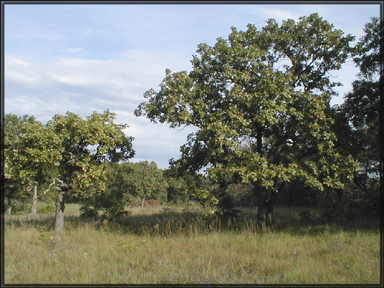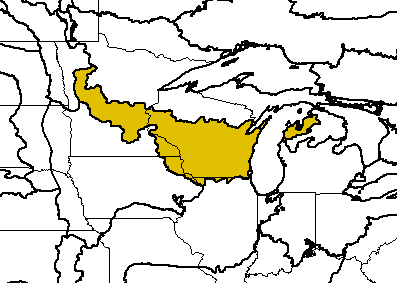
savanna, Cedar Creek Natural History Area (Long-term Ecological Research), Minnesota (c) 2005 Ron E. VanNimwegen
Bioimages home (click on an image to enlarge)
view
this page in its intended navigation context
Upper Midwest forest-savanna transition
(WWF
ecoregion
NA0415)

savanna, Cedar Creek Natural History Area (Long-term Ecological
Research), Minnesota
(c) 2005 Ron E.
VanNimwegen

Source of bioregions data:
Olson, D. M. and
E. Dinerstein. The Global 200: Priority ecoregions for global conservation. (PDF
file) Annals of the Missouri Botanical Garden 89:125-126.
Distinctiveness (1=highest,4=lowest): 4
(nationally important)
This ecoregion contains the last concentration of black soil tall-grass savanna
in the United States.*
Conservation Status (1=most endangered, 5=most
intact): 1 (critical)
Less than 5% of the habitat in this ecoregion remains intact.
Nearly all of the oak savanna in the ecoregion has been destroyed by conversion
to agriculture. Remaining semi-natural habitat suffers invasion of woody
shrubs due to fire supression.*
Associated habitats

oak savanna,
Anoka Co., Minnesota
(c) 2005 Jason J.
Husveth hires

riparian forest, Wisconsin Dells, Wisconsin
(c)
2005 James H.
Bassett
hires

black ash (hardwood) swamp, Hennepin Co.,
Minnesota
(c) 2005 Jason J.
Husveth hires

lake sedge meadow, Hennepin Co., Minnesota
(c) 2005 Jason J.
Husveth
hires

wet prairie - rich fen, Anoka Co., Minnesota
(c) 2005 Jason J.
Husveth
hires
* Ricketts, T.H., E. Dinerstein, D.M. Olson, C.J. Loucks, et al. (1999) Terrestrial Ecoregions of North America: A Conservation Assessment. World Wildlife Fund - United States and Canada. Island Press, Washington, D.C. pp. 164-166.